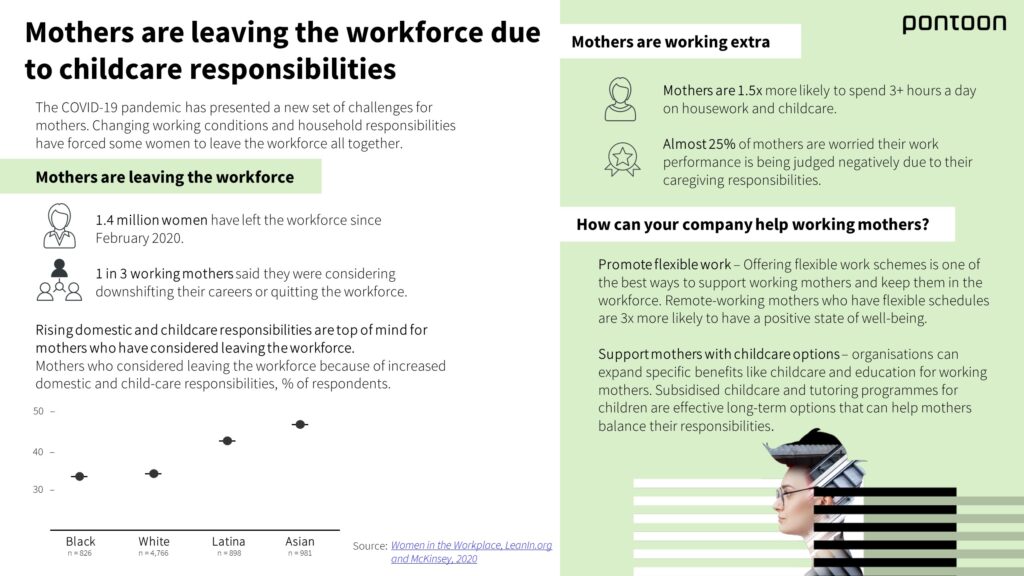Working mothers: The hidden talent market
A mother’s work is never done
A mother’s work is never done; it’s a full-time job. In my case, with two young boys, the house is run like a military operation, with early starts and late finishes. There are lists everywhere, family calendars on paper and devices.

Director, Head of Client Services EMEA
Working mothers compartmentalise work and family life by developing master multitasking skills through years of scheduling pickups, drop-offs, and everything in between. Patience, resilience, empathy, and all the “mummy skills” are valuable assets working mothers can share with the working world.
Remote work: A lifeline for working mothers
Since the pandemic, 68% of women say they prefer to work remotely, compared to 57% of men. Hybrid and remote work allows more flexibility to balance work and home life. When women become mothers, they can face stigma and bias upon returning from maternity leave. For example, due to a lack of childcare, many managers expect them to be more likely to leave the firm. On the contrary, research shows that women with childcare responsibilities are 32% less likely to leave their job if they have access to remote work.
These gender-based biases creep into career development conversations, interview processes, and salary negotiations, impeding the hiring and promotion of female talent. Business leaders must work toward a better way forward that provides equal access, support and more opportunities for working mothers. Employers have a big part to play in attracting and retaining this skilled and valuable talent market.
Gender inequality in family responsibilities
At the height of the pandemic, many working mums were forced to quit their jobs and step away from promising and fruitful careers to help with childcare and family caregiving responsibilities. The global workforce has lost more than 1.4 million women, many of them working mothers, since February 2020. This accounts for nearly 70% of job losses, including voluntary exits and layoffs.
Women’s unequal distribution of family responsibilities negatively impacts future job prospects for many women raising children. McKinsey and Lean found that US working mothers in a dual-career couple were more than twice as likely as fathers to say they’d taken on at least five hours of household chores during the early stage of the pandemic. Additionally, in two-income households where one partner gave up work, this was a woman in 80% of cases.
Many organisations failed to address these gender inequalities and the adverse side effects on working mothers. We can’t let the instability of the past two years wipe out decades of progress.

Creating equal opportunities for working mothers
Establishing long-term parity involves changing organisational cultural norms to include candid conversations about maternal bias in the workplace. There is much work to be done so that future generations, regardless of gender, will have equal opportunity in the workplace.
Employers must learn from past mistakes – avoiding performance biases and gender role assumptions to implement a talent attraction strategy that accommodates and supports working mothers, seamlessly blending home and work life.
To empower and invite back the talent lost and put them on a path to sustainable work, employers need to be thoughtful and avoid potential drawbacks for working mothers in new hybrid working models. These include addressing family care, equal opportunity, pay equity, decreasing burnout and creating fair return-to-office scenarios.
Innovative hiring practices for working mothers
Employers can incorporate women-focused initiatives that will attract, retain, and welcome back working mothers in a scarce talent marketplace. Examples of doing so might include:
Childcare incentives or onsite/offsite daycare
Around 62% of mums in the UK who return to work either work fewer hours, change jobs or stop working because of childcare costs. This is a considerable barrier when returning to the office. Young mothers want to work, but often, the financial burden of childcare is the deciding factor that keeps them out of the workplace.
Organisations can be part of the solution by investing in company-sponsored onsite or offsite childcare as a benefit to attract and retain more working mothers. For example, the Adecco Group US partners with Bright Horizons to offer discounted in-home and offsite childcare for at-home working mothers. Additional benefits include assistance finding babysitters, tutoring and test prep discounts for young adults.
Enhancing family benefits and executive learning opportunities
Executive leaders need to normalise the use of existing family benefits and leave policies, celebrating not shaming workers who leverage these services. Scheduling and enjoying family recreational activities like concerts, sporting events, and birthdays become easier when employees feel supported and encouraged by upper management to use resources. These enhanced family benefits include tutoring programmes, paid parental leave and emergency childcare support services.
Addressing psychological safety at work should be a top priority for executives looking to attract and retain working mothers. Understand that every situation and worker is different and that we all come with a set of expectations given our unique work experiences. To combat any internal bias, organisations can offer unconscious bias training, working from a top-down approach to change company culture.
Recruiter continuing education
It starts with reimagining the hiring process. Training recruiters to be more accepting of candidate employment gaps and to practise blind recruitment, avoiding biased interview questions. With new protocols and healthy boundaries that challenge culturally entrenched biases, recruiters are more likely to interview, and hiring managers are more likely to hire based strictly on skill set and cultural fit.
Customised work arrangements, job sharing, and project-based hiring
In Europe, women are four times more likely to work part-time than men. Flexible working models are critical for working mothers. Flexible work doesn’t necessarily mean working part-time or in task-oriented low-paying positions. High-paying executive roles that match a candidate’s skill set must also have aspects of flexibility. This will invite more mums to apply for management and C-suite positions.
Another creative way organisations can accelerate the hiring of working mothers is through job sharing and project-based hiring. Many highly qualified candidates cannot commit to full-time roles, preferring to work freelance, only certain months of the year or within gig platforms. Companies can attract more working mothers by diving into these alternative sourcing pools and expanding their current talent pipeline.
Flexible work and hiring will continue to evolve, offering high-performing working mothers opportunities to showcase their valuable skillsets. In a scarce talent marketplace, employers cannot afford not to leverage the working mother talent community.
Related Post
Yesterday’s data cannot solve tomorrow’s talent crisis. The global talent market is changing at an astounding pace. Hiring managers need to know what challenges lie around the corner, how and ...




